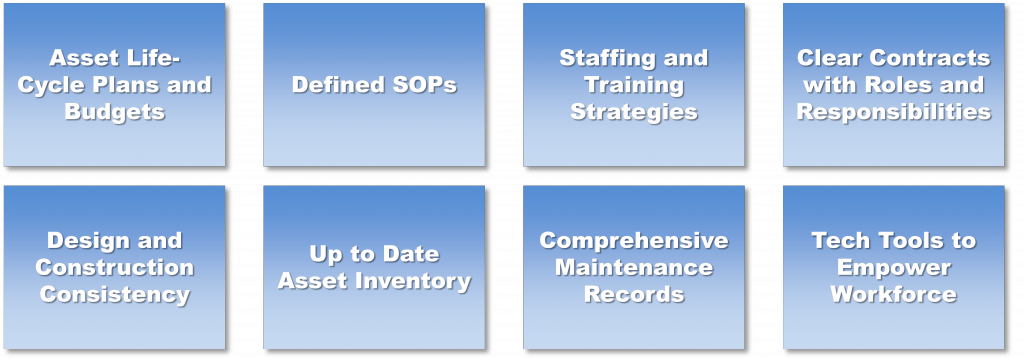Dave Sklar, principal management consultant
As the installation of Green Infrastructure (GI) continues in the water and wastewater industry at a rapid pace, many organizations are just now facing the challenge of how to manage these assets throughout their lifecycle to ensure they provide the environmental benefits they were designed to achieve. In addition to delivering a balance of positive triple bottom line (TBL) impact – social, environmental and financial – GI assets are often also directly tied to regulatory requirements. From this perspective, ensuring that assets are properly maintained from the beginning is critical in delivering on commitments made to ratepayers and stakeholders. In addition, achieving program milestones and performance targets ensures continued program support.
Across the industry and around the world, there are very different drivers for GI. Depending on regulatory, service level and community needs, utilities are placing different emphasis on specific components of GI strategies, which can drive very different outcomes and benefits. Some of the more significant and common drivers include:
- Regulatory requirements and agreements
- Cost efficiencies versus typical gray infrastructure
- Neighborhood and social enhancements
- Stormwater, flood control and water quality challenges
- Alignment with sustainability initiatives
No matter what the driver, utilities must examine the balance of stormwater, wastewater, potable water and reuse strategies and decide what level of commitment they want to make to GI to help cost-effectively meet regulatory and service level objectives. For those that decide to make some level of commitment to GI, there are critical questions that must be asked in developing an appropriate strategy:
- Where to locate infrastructure?
- What type(s) of GI should be considered?
- How much GI to build and what is the desired speed of impact?
- What is the balance of public versus private participation?
- What types of public grants/incentives to offer and how to fund?
- How to build business cases and track impacts?
- How to develop organizational skills, competencies and tools? –
To answer the above strategic questions requires taking the time to establish a formal business plan and strategy, as you would for any new venture. However, this should not be a new exercise for most utilities and the same strategic planning and asset management policies that are employed for water, wastewater and stormwater infrastructure can also be applied successfully to GI.
Utilities at any stage of their GI programs can benefit from following several key steps in developing a comprehensive asset management program and ensuring a successful lifecycle cost strategy is put in place. One of the most fundamental elements is to develop a formal business strategy and asset management plan that defines the goals and objectives of the program in clear terms and establishes formal asset life-cycle plans that are properly funded and implemented through consistent SOPs.
Finally as part of the business plan, utilities need to develop a solid staffing strategy to ensure the organization is properly equipped to effectively operate and maintain these assets. Once again, there are some significant differences from grey infrastructure that must be considered.
- GI requires forestry, horticulture and landscaping expertise vs. mechanical, electrical and structural qualifications – need to recruit different skill sets
- GI requires a primarily field based workforce vs. mix of facility and field based staff – need advanced mobile workforce tools
- GI requires extensive management and coordination of outside resources for specialized tasks vs. in-house efforts – additional coordination and work sharing with contractors and other City/Municipal departments
- GI inspections are required for third-party infrastructure vs. utility owned assets – need inspection skill sets and mobile workforce tools
As it is still a new field in the early stages of development, utilities should continue to exchange ideas and lessons learned from others and evaluate the specific costs and benefits of GI based on local circumstances. As design standards, approaches and technologies evolve, utilities will be better equipped to manage risks and ensure effective investments in GI that can offer cost effective social and environmental benefits in parallel with traditional grey infrastructure. There are several fundamental components to any GI strategy that utilities should proactively address:
- Develop overall business plans and strategies for staffing, materials/equipment, IT systems, data collection and analysis to provide a strong organizational foundation.
- Ensure that long-term maintenance strategies are developed in parallel with design and construction so that utilities have a solid plan from the day assets are commissioned.
- Apply LCC and TBL analysis to validate realistic long-term budgets and ensure that assets are properly maintained and operated to achieve their desired impact.
- Always be prepared to review and re-evaluate strategies frequently as a lot of the information is new and programs will see significant evolution over the next several years.
Is your utility equipped to manage your new or planned GI assets? Tell us about the GI asset management strategies that are working for your utility and where you would like to improve.

